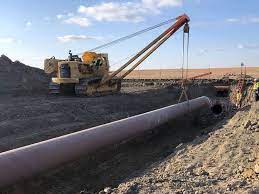According to analysts and traders, an interruption of the major oil pipeline from Canada to the United States may reduce crude supply to two oil refineries and have an impact on stockpiles at a significant U.S. storage facility.
About 600,000 barrels of Canadian petroleum are transported daily (bpd) to the United States via TC Energy’s Keystone pipeline. It was shut down late on Wednesday after a break released almost 14,000 barrels of crude into a Kansas creek, making it the country’s biggest oil disaster in almost a decade.
According to Michael Tran, managing director at RBC Capital Markets, “the key question remains to be the length of the potential outage… the longer the duration, eventually, of course, means either tighter inventories in Cushing or heavy (crude) on the Gulf Coast.”
The storage hub in Cushing, Oklahoma, where the line directly terminates, is currently around a third full and holding close to 24 million barrels.
According to AJ O’Donnell, a director at pipeline researcher East Daley Capital, if the outage lasts more than 10 days, Cushing storage could be reduced to almost the operational minimum of 20 million barrels.
According to Harshit Gupta of Arc Independent Research, volumes in the fourth quarter will be “materially affected” because Keystone will probably operate, at least initially, at a significantly lower pressure.
According to estimates by East Daley and data analytics company Wood Mackenzie, several pipelines connecting Canada and the United States are at or nearly at capacity.
“There is insufficient space to take 600,000 barrels each day. Currently, there are just not enough pipes “explained O’Donnell.
Downstream from a crucial intersection in Steele City, Nebraska, where Keystone separates to go into Illinois, the leak in Kansas occurred. The other part of the line that was impacted by the leak won’t resume until regulators allow a restart, but that section of the line might.
According to sources cited by Bloomberg, TC Energy plans to restart a pipeline piece that transports oil to Illinois on Saturday and a pipeline segment that transports oil to Cushing on December 20. The pipeline’s reinstatement into service is being considered, according to TC Energy.
Volumes from Cushing to the Gulf have already decreased. Following the discovery of the leak, Wood Mackenzie calculates that volumes on TC Energy’s Marketlink pipeline, which runs from Cushing to Nederland, Texas, decreased by around 300,000 bpd to less than 500,000 bpd.
Refineries along the Gulf Coast, which can run out of heavy Canadian crude, can get their supplies from facilities offshore Louisiana as well as from Colombia, Mexico, and Ecuador.
On Thursday, U.S. physical crude oil grade prices were volatile. According to O’Donnell at East Daley, volatility is likely to remain as long as Keystone is not operational.
Although the market’s response on Friday was subdued, a protracted pipeline outage may cause a bottleneck in Alberta and depress prices for Canadian oil.
According to a broker in Calgary, the benchmark Canadian heavy grade, Western Canada Select (WCS), last traded for December delivery at a discount of $27.70 per barrel to the benchmark for U.S. oil futures.
December WCS traded as low as $33.50 below U.S. crude on Thursday before ending the day at $28.45 disadvantage.

















